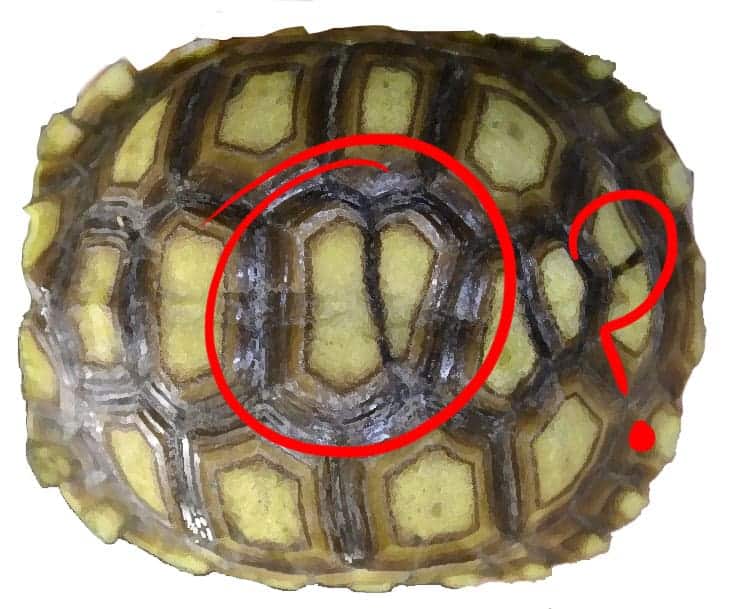While certainly unusual, irregular scutes on tortoises do not negatively impact their health in any way. They will be as healthy as a tortoise with conventional shell scutes. Irregular scutes are a cosmetic issue, but not a health threat.
A tortoise’s shell is extremely important. Not only does it allow the reptile to absorb warmth and UV from sunlight, but it also serves as a way to protect the vital organs within the body. It’s only natural that someone who has never owned a tortoise before may be concerned if they see a tortoise’s shell has developed irregular scutes.
It’s hard to discover the cause of irregular scutes in a recently acquired tortoise, but more importantly, it’s even harder for you as an owner, because you’ll start worrying about the tortoise’s health. But are irregular scutes really a problem worth worrying about?
I can tell you that I don’t think so, but let’s look into the issue a little more to give you peace of mind.
What Are Irregular Scutes?
A tortoises shell is made up of a series of distinct sections, or ‘plates’ known as scutes. These fuse together to make up the shell, and continue to grow larger as the tortoise grows. In mature tortoises you’ll notice that each scute gradually builds in a series of ever growing layers, not unlike the manner that a tree trunk grows. However, don’t be tempted to determine the age of a tortoise by counting these layers, they don’t grow with enough regularity for that to be accurate!
In some tortoises this layered growth is especially evident as a result of pyramiding.
When a tortoise’s shell has irregular scutes, it means that there is an abnormal number of scutes which creates a more unique look, as they are not aligned properly. Usually, when the issue arises, it’s either because there are additional scutes or missing scutes, which then naturally align accordingly. The condition is also known as split scutes.
It is classified as a cosmetic deformity of the shell, and it makes a tortoise more unique.
What Causes Irregular Scutes?
It isn’t known for certain why some tortoises are born with irregular scutes. Most experts believe it can be attributed to both genetic and environmental factors.
The most widely accepted potential cause is low humidity or temperature during incubation. When the developing tortoise fetus is still in the egg there may be some changes in its surrounding environment that lead to irregular scute development.
If you are a breeder, or are considering trying your hand at breeding, this is just one of many (more important) reasons why you must make sure to maintain both the correct humidity and temperature when incubating tortoise eggs.
As mentioned, a genetic predisposition might also be the cause of irregular scutes. If both parents of a tortoise had split scutes, then it is very likely for the hatchling to have a genetic predisposition to the condition as well.
Fortunately split scutes are not a danger to a tortoise’s health, so shouldn’t feel unecessarily guilty if you hatch a tortoise with split scutes. They are simply be a cosmetic anamoly, and pose no danger. What’s far more important is everything you do from this point onwards in terms of care.
Why Some People Have a Problem with Them and Others Don’t?
Whether you have a problem with the look of the irregular scutes or not is up to you. You’ll notice that a lot of tortoise lovers have differing views on split scutes. Dare I say, opinions are ‘split’ on the subject?… Sorry!
Some people don’t have a problem with them at all. Actually, they see it as something beautiful. The irregularity of the scutes creates unique patterns, making the tortoise more beautiful in their eyes. Particularly when it comes to additional scutes, many people seem to love it, especially if there is already a very beautiful pattern on the shell. In their eyes additional scutes only add more beauty and more value.
For some it may also be more tempting to buy a tortoise with irregular scutes rather than one with a normal shell. Some people don’t really care that there’s an irregularity problem as they’ll love the tortoise either way.
At the same time, other people are not into this look and would rather avoid getting a tortoise that has a cosmetic problem. To them, split scutes are an imperfection, and they would prefer to get a tortoise with a conventional looking shell.
Some tortoise lovers are put off by a tortoise with irregular scutes, perhaps more understandably so, because it may indicate that other health issues are present or likely to occur at some point in future. After all, if a tortoise didn’t have the right conditions during incubation, who knows how well it’s been treated since hatching.
And believe it or not, many people in China consider it bad feng shui to house a tortoise with irregular scutes.
Is There Any Advantage to Getting a Tortoise with Irregular Scutes?
Getting a tortoise with irregular scutes might, in some cases, lead to them being sold at a lower price. Since it’s considered an imperfection by so many, breeders might sell the reptile for a much lower price; perhaps $10-$20 cheaper than a ‘perfect’ specimen. So whilst it’s not a huge saving, if you’re looking for a tortoise and want to buy one for a lower price, you can get one with split scutes as long as you don’t mind the imperfection.
Final Thoughts
Irregular scutes are not harmful to the tortoise in any way. It’s nothing but a cosmetic issue, which will not affect the pet’s health. Indeed a tortoise with an irregular scute pattern can in fact be very beautiful, and if you ask me it’s a great way to have a unique pet.


